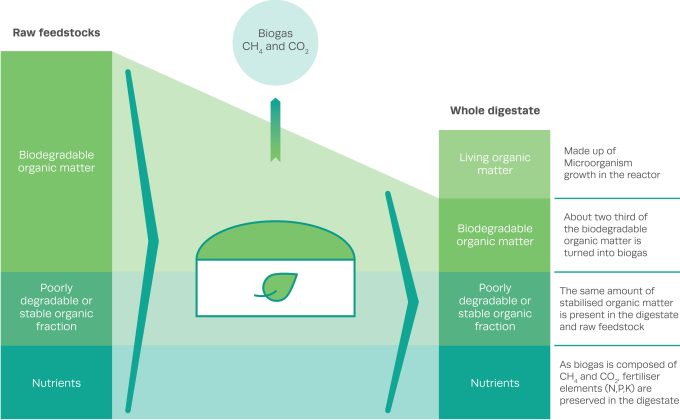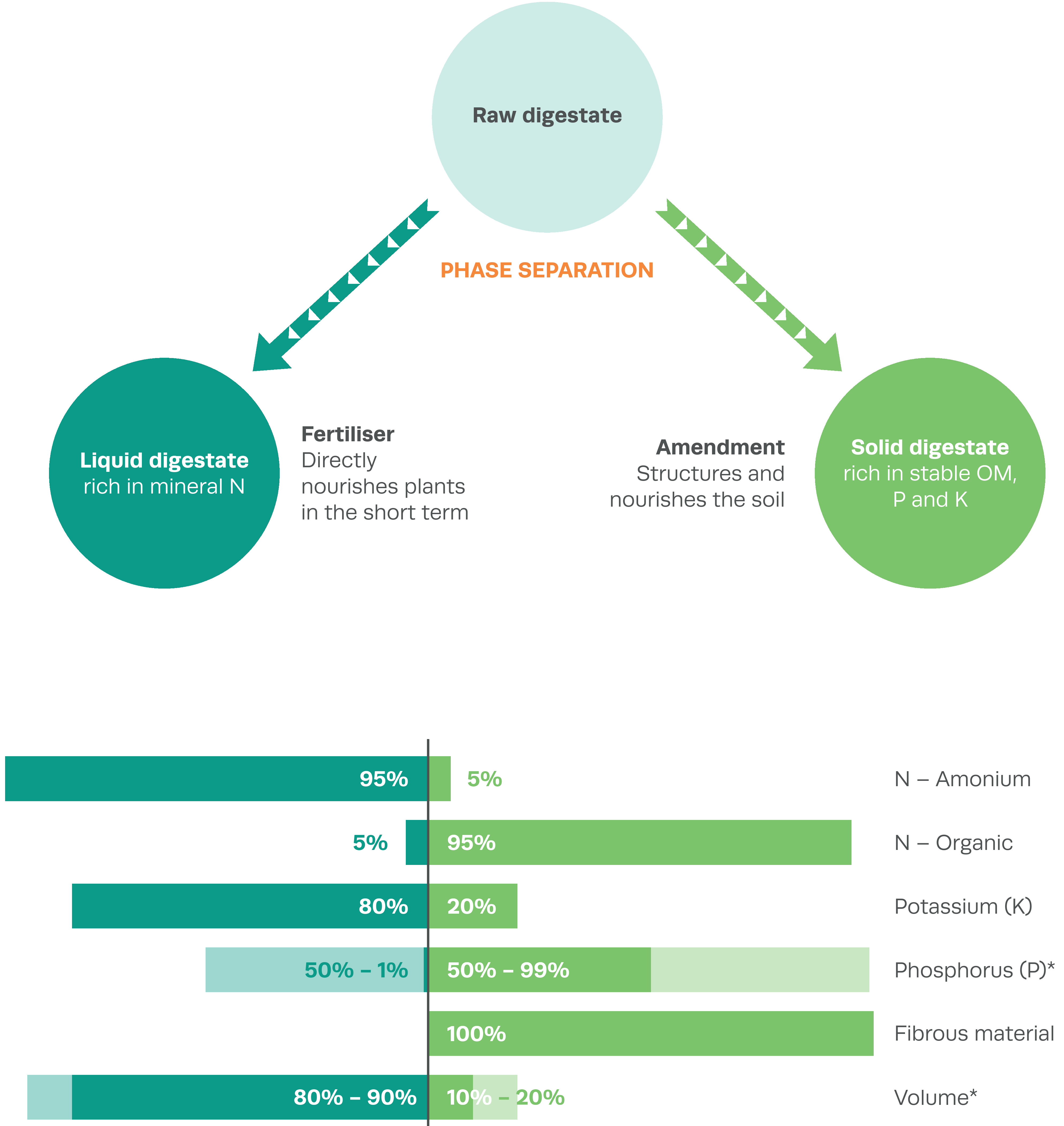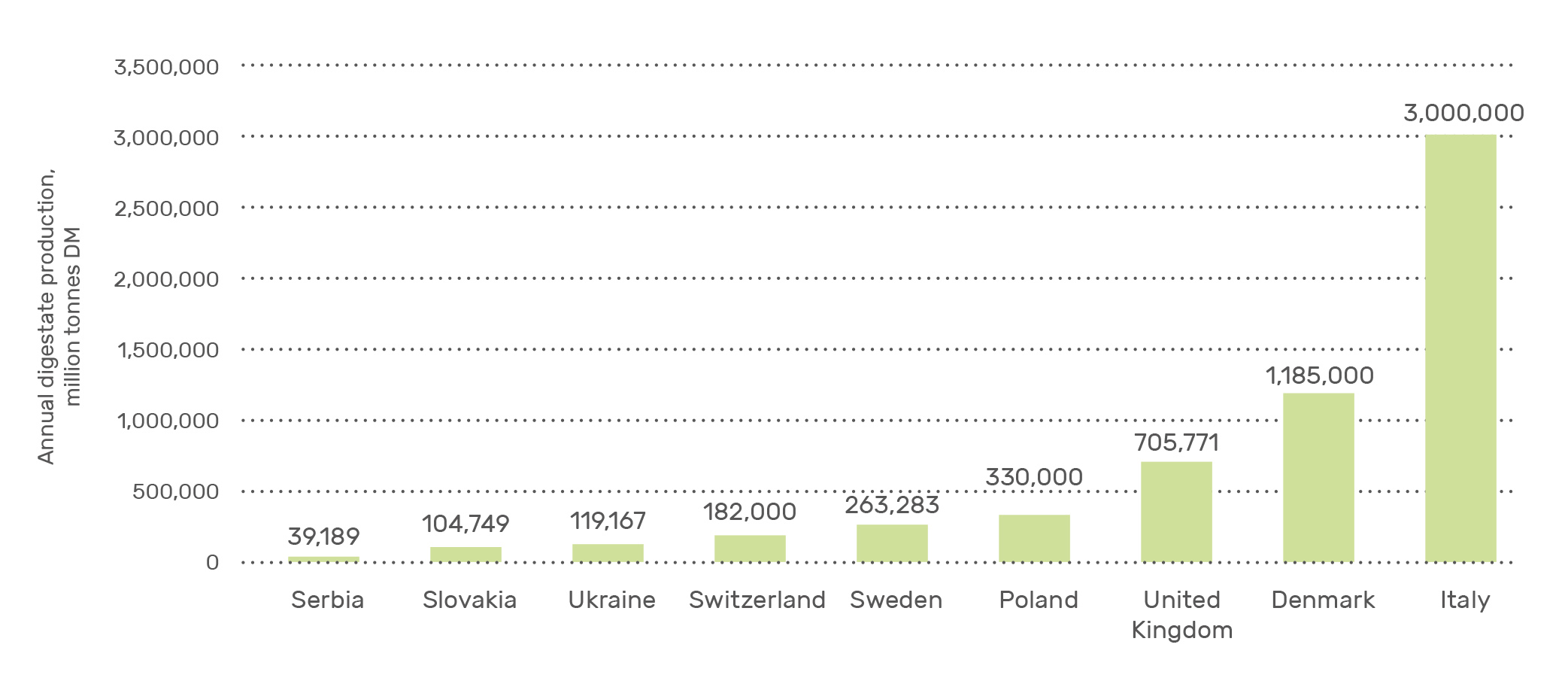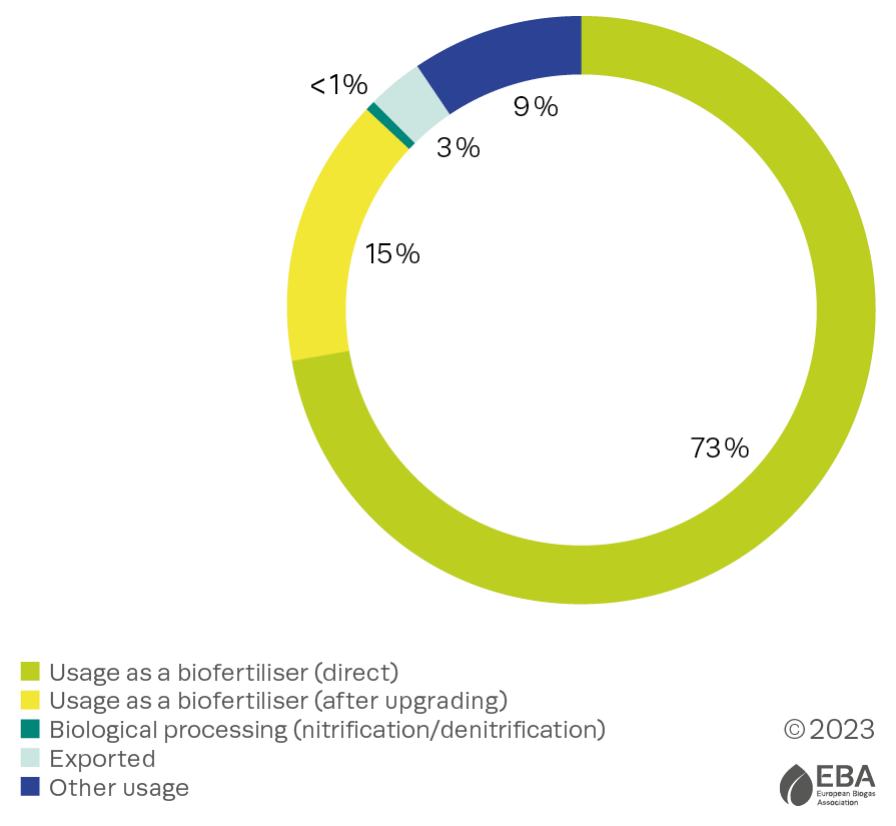The review is based on the materials of the paper Exploring digestate’s contribution to healthy soils, published by the European Biogas Association in April 2024. This report provides key takeaways of the digestate in the frameworks of its fertilizing value, boosting the green transition on the farm and country level, framework compliance, and novel nutrient recovery pathways. Consider the most important of them.
Digestate composition, its application, and effect on the soil and environment
Digestate, a co-product of anaerobic digestion (Figure 1), contains a portion of the organic matter (about 1/3) and mostly the entire mineral fraction from the initial feedstock. Three main forms of organic matter (OM) are present in digestate:
- Poorly/non-degradable OM, such as lignin and cellulose.
- Living OM, composed of microorganisms.
- Biodegradable OM, composed of soluble sugars and hemicellulose.

Figure 1. The anaerobic digestion process. Source: EBA.
As for the nutrient composition of the digestate, the table below gives an overview of the literature-based average nutrient composition.

What makes digestate unique and distinct as a fertilizer?
- The ammonium/organic nitrogen ratio in digestate is higher compared to the raw feedstock, and the percentage of readily available minerals in the form of ammonium increases.
- Digestate retains its ability to form humus, which remains unchanged compared to the substrates from which it originates.
- The percentage of ammoniacal nitrogen is higher in the digestate than in the original raw material, which increases its fertilizer value.
- Its application back into soil closes nutrient cycles such as N, P, and K.
- In contrast to the exclusive use of conventional synthetic fertilizers, long-term fertilization with digestate enhances soil structure, soil aeration, and water storage capacity.
- It acts as a carbon sink thanks to its ability to store carbon in soil.
- Since digestate is a biologically stable product, this results in significantly reduced volatile organic compound emissions and odors during digestate storage and application compared to the initial feedstock as well as reduced naturally occurring CH4 and N2O emissions compared to, for example, raw manure.
- Animal and plant pathogens are either vastly diminished or wholly eradicated during anaerobic digestion leaving digestate as a sanitized product.
- Reduced greenhouse gas emissions due to: the capture of CH4 during digestion which otherwise would have been emitted during uncovered storage, reduction of synthetic fertilizers production, and soil carbon sequestration among other factors.
Digestate use and processing
Leaving a biogas reactor, digestate is present in a raw form, which is a mix of solid and liquid fractions. It can be applied straightforwardly, though many biogas operators go for mechanical separation of digestate into liquid and solid fractions for main reasons such as to reduce transport costs, to ease spreading, and to increase nutrient value (Figure 3).
The main approaches for the separation include centrifuges, decanter screw presses, sieve belt presses, or drums. Further processing of the separated digestate includes:
For solid fraction:
- Drying, composting, and pelletizing to facilitate its storage, management, transport, use, and merchandizing/
- Application of pyrolysis and gasification to produce renewable oil, syngas, and char.
- Application of hydrothermal carbonization to dilute N and P from the solid fraction and produce only C-rich hydrochar.
For liquid fraction:
- Chemical treatment to recover ammonia (in the form of ammonium sulfate).
- Use of reverse osmosis to recover water and produce mineral-rich concentrate from the liquid fraction.

Figure 3: Typical physical and chemical properties of the solid and liquid fractions of the digestate. Source: EBA.
Some of the novel digestate applications include the production of carbon materials for energy storage applications, the synthesis of nanomaterials, char, and biofuels, as well as microbial products. Innovative pathways of digestate usage are:
- Digestate for the cultivation of insects (black soldier flies).
- Digestate as a pretreatment agent (for anaerobic digestion of lignocellulosic biomass).
- Digestate in electrochemical processes (Fuel/Electrolysis Cells).
- Digestate as a medium for hydroponics.
- Production of volatile fatty acids.
- Production of bio-stimulants.
- Recovery of bio-ammonia to biohydrogen.
- Use of the liquid fraction of digestate for microalgae growth.
Digestate production and end-use in Europe
Current digestate production in Europe, as of 2022, is 31 million tonnes of DM per year. While potentially, this volume could reach 75 million tonnes of DM per year by 2030 and 177 million tonnes of DM per year by 2050. The 2022 data on the European digestate production per capita of selected countries is presented in the diagram below.

As for the end-use of digestate, it is estimated that 73% of Europe’s digestate is applied directly as a bio-fertilizer, and about 15% of the digestate produced is upgraded before being applied to agricultural fields (Figure 5). The remaining digestate goes to other applications such as horticulture, soil production, landfill coverage, biological processing, etc., or is exported.

Figure 5. Digestate end use in Europe. Source: EBA.
Regulatory barriers to utilization and merchandizing of digestate
Despite digestate being an environmentally friendly solution for handling waste and its ability to close nutrient cycles and reduce GHG emissions, the biogas operators that produce and sell digestate are required to follow complex, heterogeneous, and strict guidelines and policies set both externally (at the EU level) and internally (at the state level). The main barriers and setbacks set by the EU regulatory framework are:
- The Waste Framework Directive 2008/98/EC the implementation of which in the EU Members varies significantly, resulting in digestate being classified under different types of recovery or recycling operations.
- The Fertilising Products Regulation (EU) 2019/2009 allows Member States to set different sets of rules to mark digestate, thus different quality assurance schemes will need to be performed.
- The Nitrates Directive 91/676/EEC obligates the Member States to manage the manure storage and application and sets the limit for the application of N from manure and digestate, derived from it.
As indicated in the paper, the primary regulatory barriers highlighted by the Member States are the Nitrates Directive limit which restricts the application of digestate from manure, and that the framework for digestate is complex and far from being harmonized across Member States.
This review was prepared for SAF Ukraine by Petro Kucheruk and Taras Koziupa, experts at the Bioenergy Association of Ukraine.